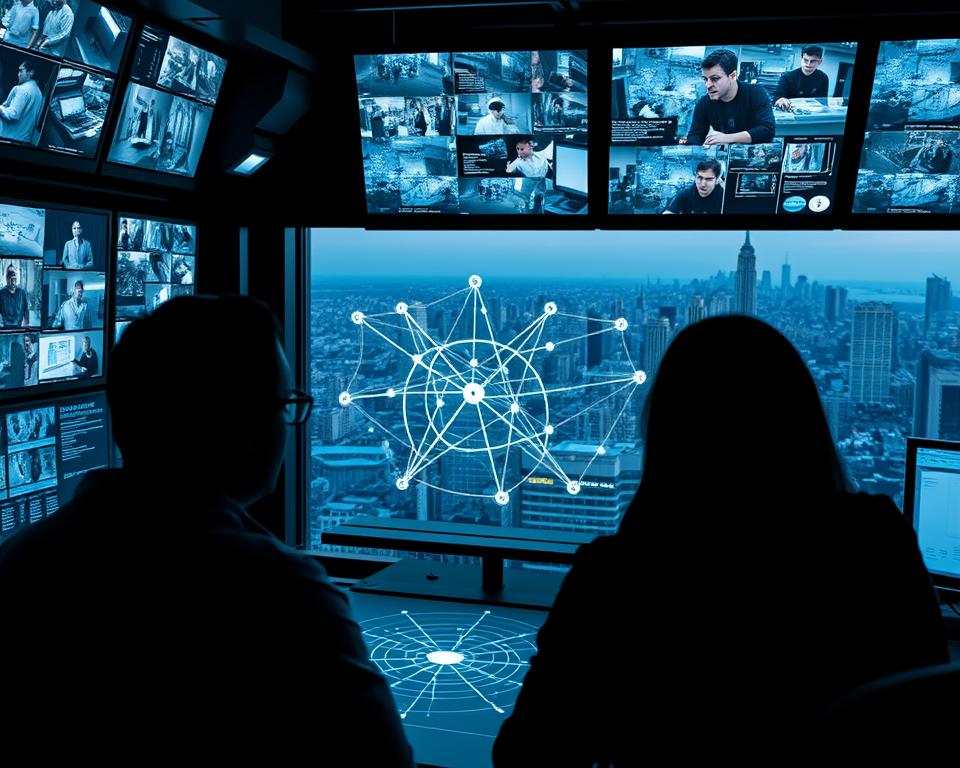Safeguard Your Organization’s Assets via Corporate Security
Picture a scenario where each entryway, server room, and data point stays protected from dangers. In today’s organizations, protecting physical premises and digital systems isn’t optional—it’s essential for survival. Why do 68% of businesses note vulnerabilities in their safety protocols even after boosting investments? The solution hinges on partnering with providers who give results, not just pledges.
Divine Protection Services stands apart by blending advanced commercial security monitoring with human expertise. Their methodology isn’t limited to securing doors—it predicts dangers before they grow. Whether it’s retail outlets or corporate headquarters, clients obtain customized solutions that adjust to changing threats.
Effective safeguarding transcends cameras and warning systems. It requires real-time response teams trained to handle emergencies, plus cybersecurity measures that guard sensitive information. This dual focus ensures both employees and assets stay secure, creating environments where growth thrives.
Boasting a 97% retention rate, their outcomes speak for themselves. Within half a year of teaming up, a hospital network saw an 83% reduction in theft. Another tech firm prevented a major data breach through proactive threat detection. Peace of mind isn’t a luxury—it’s what happens when preparation meets execution.

Are you set to reshape the defense of your critical assets? Let’s delve into what real security readiness means.
Reasons to Select Divine Protection Services for Your Corporate Safety
Successful security approaches fuse technology with human acumen for optimal results. Although vendors like ADT deliver uniform packages, Divine Protection Services customizes strategies that adapt to your specific operational requirements. Their comprehensive strategy covers gaps that other providers frequently ignore.
Dependable Expertise Coast to Coast
Backed by 15 years of on-the-ground experience, their crew deals with concerns from retail theft to corporate surveillance. Unlike Securitas Technology’s template-based systems, they deploy:
- Intelligent entry management that adjusts to foot traffic
- Machine-learning video monitoring that interprets actions, not only movement
- Cyber protection merges for both physical and virtual infrastructures
Customized for Your Business Processes
One regional medical center cut medication theft by 74% through their step-by-step deployment model. Their specialists initially studied movement patterns, then placed biometric entry systems in critical zones. This precision contrasts with generic “security solutions” that treat warehouses and tech startups identically.
“They’re not just vendors—they’re dedicated allies,” notes a Fortune 500 risk manager. Live-monitoring units coordinate with your team, forming defense layers beyond what fixed systems offer. Whether upgrading existing infrastructure or starting fresh, their plans grow as your needs change.
An Outline of Holistic Security Offerings
Modern businesses require protections that adapt quicker than new threats arise. Divine Protection Services offers personalized solutions merging real-time oversight, AI-based analytics, and cohesive system integration. Their methodology integrates separate tools into a single defense layer for both physical and cyber risks.
State-of-the-art technology underpins these methods. Cloud-based management platforms let teams oversee access controls, video feeds, and sensor networks from one dashboard. “The next generation relies on platforms that foresee challenges before alerts go off,” remarks a TechCrunch cybersecurity expert.
Primary features involve:
- AI-powered video analysis spotting abnormal activity signatures
- Encrypted data storage meeting strict compliance standards
- Automated incident reporting that speeds up response times
Blending hardware such as 4K cameras with ML software reduces weak points. With this layered tactic, a Midwest distribution center cut warehouse break-ins by 91%. The result? Operations stay smooth, and assets remain protected without constant manual checks.
Such flexible solutions expand with evolving demands—whether opening new sites or enhancing current systems. Backed by round-the-clock assistance and periodic technology upgrades, customers shield their investments for the future while retaining strong risk oversight.
Comprehending Business Security Demands for Contemporary Organizations
No two companies experience the same risk profiles. A downtown law firm faces different risks than a suburban warehouse or a medical clinic. Hence, generic solutions frequently overlook concealed blind spots. Effective strategies start by mapping out what your operations truly require.
Analyzing Risks and Exposure
Premier firms like Divine Protection Services start by creating 3D models of physical premises and digital infrastructures. They examine access points, information routes, and team workflows. A car parts maker realized that 62% of after-hours operations happened in unsupervised storage spots—a blind spot old-school setups missed.
Key evaluation methods include:
- Infrared checks pinpointing camera coverage gaps
- Controlled breach simulations to highlight response gaps
- Staff behavior monitoring exposing inadvertent security failures
Identification devices are crucial in this stage. Advanced sensors flag unusual movements near restricted areas before incidents occur. One Midwestern hospital utilized heat-map tools to slash unauthorized access to meds by 89%.
Tailored solutions adapt to industry-specific challenges. Retail businesses could target inventory shrinkage algorithms, while tech enterprises zero in on secure entry protocols. As one risk analyst notes: “Protection isn’t about barriers—it’s about smart filters that let the right people in and keep threats out.”
Next-Gen Video Security and Alarm Technologies
Modern surveillance tools do more than watch—they predict and prevent. Leading providers like ADT and Securitas Technology now deploy systems that analyze behavior while stopping threats in real time. Such offerings establish smart perimeters, merging acute surveillance with swift intervention.
Live Video Surveillance Capabilities
Ultra-HD cameras now provide crisper visuals than before, even in poor lighting. ML-driven analytics review footage for odd motions, such as someone loitering near off-limits areas. Core features include:
- 4K resolution with 360-degree coverage for parking lots and stockrooms
- Online storage maintaining recordings for more than 90 days
- Immediate notifications delivered to mobile devices upon glass-break detection
One retail brand saw a 41% drop in shoplifting thanks to motion-detecting cameras that trail suspects on their own. This tech helps teams act before incidents escalate.
Next-Generation Alarm and Detection Solutions
Advanced alarms now interface with other security equipment. When a window detector goes off, adjacent cameras focus as entry points seal. Securitas reports response times drop by 58% with this integration.
Latest vibration devices sense attempts at interfering with safes or server cabinets. Thermal sensors also identify heat spikes from overheated equipment. These tiers operate akin to a digital nervous network—subtly watchful until intervention is required.
“It’s beyond simply louder sirens,” notes an ADT systems engineer. “It’s smarter signals that pinpoint exact trouble spots.” From warehouses to offices, these systems adapt to protect what matters most.
State-of-the-Art Access Control Systems
The right key shouldn’t just open doors—it should know who’s holding it. Modern access control systems act as intelligent gatekeepers, verifying identities before granting entry. Vendors such as ADT now employ mobile credentials and fingerprint biometrics rather than cloneable keycards.
Sophisticated platforms merge biometric validation with live camera streams. Facial ID programs match visitors to vetted lists while 4K cameras log all entry attempts. This dual-layer approach deters unauthorized access before it happens.
Consider a Boston medical center that slashed after-hours intrusions by 76%. They deployed palm-vein readers at drug dispensary doors and connected cameras to motion detectors. Authorized personnel passed smoothly, while strangers prompted instant notifications.
Modern capabilities fuse physical defenses with digital safeguards flawlessly. Web-hosted consoles allow administrators to change authorizations remotely, disabling entry outside work hours. Integrated alarms lock down areas if sensors detect forced entry attempts.
“Precision matters more than ever,” notes an ADT field engineer. Tailored controls protect sensitive zones without disrupting workflow. From laboratories to executive suites, intelligent platforms allow only approved personnel free movement—safeguarding teams and resources.
Preemptive Breach Detection and Round-the-Clock Surveillance
Dangers don’t sign off at 5 PM—they attack when vigilance wanes. Divine Protection Services leverages AI-based sensors that adapt to normal activity patterns across your sites. Unlike typical solutions from ADT or Securitas Technology, these sensors anticipate abnormalities before they amplify, securing rapid threat mitigation.
Constant Monitoring, Speedier Responses
24/7 surveillance cuts reaction times in crises. When sensors detect unusual motion near restricted zones, alerts go straight to both your team and trained specialists. A logistics facility decreased incident handling time from 22 minutes to 3.7 minutes via this tactic.
Core offerings include:
- Machine-learning models that adjust to evolving intrusion methods
- Infrared detectors recognizing heat patterns in darkness
- Self-initiated lockdown sequences activated during intrusions
Real-time dashboards show live feeds and threat levels, letting managers act decisively. One retail partner cut post-business-hours break-ins by 67% in just four months. As their COO observed: “It’s not just a watcher—it calculates three moves ahead.”
Continuous monitoring fosters confidence among clients and staff alike. Whether managing late-night alerts or holiday vulnerabilities, uninterrupted coverage stabilizes operations. With risks evolving daily, proactive protection isn’t optional—it’s how modern organizations stay ahead.
Convergence of Advanced Protection Technologies
Modern security goes beyond locks—it embraces intelligent interconnections. Leading platforms like Securitas Technology’s secureStat® HQ™ merge sensors, cameras, and analytics into one responsive system. This integration turns isolated tools into a unified shield that adapts to risks in real time.
4K cameras combined with AI-based video analytics detect odd behaviors quicker than human operators. As an example, retailers currently implement motion analysis to flag loitering by high-risk merchandise areas. The technology issues warnings before incidents intensify, enabling team intervention early.
Current configurations pair rugged devices with cloud-driven analytics. Access control panels sync with mobile apps, allowing remote permission updates. A Midwest hospital reduced unauthorized entry by 79% using biometric scanners that integrate with thermal sensors.
These linked systems offer real-time insights through control panels. Supervisors monitor live video, danger indices, and mitigation steps in a single interface. “Unified systems allow us to react to patterns, not solely alarms,” remarks a Securitas developer. From fire detection to data protection, seamless coordination meets evolving needs while keeping operations smooth.
Strengthening Safety via Integrated Security Networks
Integrated security systems act like a digital nervous system—connecting every layer of protection to respond as one. As cameras, alarms, and entry systems cooperate, they form settings where threats are detected faster and managed more intelligently. Suppliers like ADT and Securitas Technology today provide platforms where sensors initiate automated safeguards, lowering human oversight errors.
Smart Technology in Safety Systems
Today’s deployments blend observation gear with instant analytics to anticipate challenges before they intensify. As an example, ADT’s Command interface pairs 4K cameras with motion-detecting alarms. When a detector senses odd movement, adjacent cameras focus as doors lock on their own. This seamless coordination cuts response times by up to 65% compared to standalone devices.
Networked gadgets also adapt based on everyday rhythms. Intelligent cameras assess pedestrian flows, marking lingering near off-limits areas. Thermal sensors in warehouses detect heat spikes from equipment malfunctions. “Unified systems transform raw inputs into actionable intelligence,” mentions a Securitas specialist. One distribution center cut break-ins by 78% through these layered protection measures.
Continuous analytics refine operations over time. Systems track which entry points face repeated tampering attempts or which hours see peak vulnerabilities. This information guides teams in updating protocols, guaranteeing defense evolves with dangers. With everything working in sync, organizations gain peace of mind knowing their safety net grows stronger daily.
Customized Protection Offerings for Varied Sectors
Every industry faces unique threats that demand specialized defenses. A healthcare facility’s requirements vary greatly from a shop’s, akin to how a tech startup’s risks differ from a storage facility’s. Off-the-shelf solutions frequently have holes—Divine Protection Services fills them with strategies based on industry-specific circumstances.
Addressing Industry-Specific Challenges
Medical institutions focus on patient welfare and drug security, whereas retailers tackle coordinated shoplifting. A local medical center reduced medication theft by 74% with biometric readers in sensitive areas. Meanwhile, a retail franchise dropped shoplifting by 41% employing AI-driven cameras following suspect actions.
Essential steps differ across industries:
- Secure data encryption standards for banks
- Thermal sensors in manufacturing plants to detect equipment fires
- Workstation panic triggers for office campuses
Developing Custom Security Strategies
Divine Protection Services starts with deep-dive audits of physical layouts and digital workflows. They map entry points, employee habits, and data flow patterns. For a logistics company, this revealed 62% of unauthorized activity occurred near loading docks—now monitored by 360-degree cameras.
“They asked questions others didn’t,” comments a clinic director. Strategies combine innovations such as intelligent entry systems with team training modules. Immediate dashboards permit leaders to modify protocols as risks change, ensuring protections remain proactive.
Effortless Setup and Swift Reaction Features
A hassle-free deployment alongside quick support ensures continuous operations. Top vendors such as ADT emphasize same-day deployment, installing alarm systems without interrupting routines. Their credentialed technicians show up geared up, typically wrapping up installs in under four hours.
Rapid rollout depends on meticulous preparation. Installers inspect locations ahead of time, charting cable routes and device positions. This prep work lets them:
- Install sensors during off-peak hours
- Align fresh hardware with established setups
- Validate every element before completion
ADT guarantees 24/7 monitoring teams respond to alerts within 30 seconds—day or night. “Every moment matters in crises,” comments their operational head. When a NYC store endured a break-in, law enforcement reached the site in 3.7 minutes due to immediate alerts sent to nearby units.
Predictive upkeep maintains system dependability over time. Suppliers furnish next-day service windows for pressing problems, limiting downtime. With streamlined setups and rapid support, organizations maintain continuous protection while focusing on growth.
Ongoing Security System Management and Maintenance
Effective safeguarding doesn’t conclude with setup—it prospers through regular upkeep. Divine Protection Services ensures your defenses stay sharp with proactive updates and 24/7 oversight. In contrast to ADT’s routine service agreements, their crew merges foresight analytics using SecureStat® HQ™ with direct inspections.
Expert Support and Service
Continuous oversight squads fix issues before they hamper operations. Certified technicians perform monthly system checks, updating software and testing backup protocols. A retail client experienced threat resolution 94% quicker after enrolling in their servicing plan.
Core offerings include:
- Automatic device updates for cameras and sensors
- Combined fire alarm checks in non-peak periods
- Monitoring reviews confirming best camera placements
Dedicated client success leads offer priority help via phone or portal. “They corrected a sensor error remotely as we slept,” recounts a hospital client. Proactive steps such as recalibrating motion sensors slashed false alerts by 73% at one distribution center.
Using live dashboards to monitor system status, supervisors detect patterns such as battery depletion or network failures. This vigilance reduces theft risks and keeps every layer performing at peak capacity—because true safety never takes a day off.
Boosting Corporate Output with Solid Security
Powerful defense tactics do more than avert setbacks—they drive expansion. When staff feel protected, performance improves. One manufacturing plant saw output jump 18% after upgrading their safety protocols. “Data insights” are crucial here, uncovering process bottlenecks as they strengthen protections.
Staff flourish in workplaces where threats stay contained. Stores deploying smart detectors witness a 32% drop in disturbances during high-traffic periods. This stability lets staff focus on customer interactions rather than worrying about vulnerabilities. A Midwest distributor reduced equipment downtime by 41% through predictive maintenance alerts tied to their monitoring systems.
Long-term benefits compound over years. Clients using integrated solutions see 23% faster decision-making thanks to real-time dashboards. “Our standing rose when customers observed our enhanced security measures,” relays a tech company VP. Customer trust grows when operations run smoothly without visible security hassles.
By aligning protective measures with core goals, organizations build resilience that pays dividends. The result? Happier teams, loyal clients, and sustained success that weathers evolving challenges.
Definitive Corporate Protection Strategy
What distinguishes adequate security from outstanding defense? Seamless unity across every layer. Modern strategies thrive when control systems, surveillance tools, and response protocols act as one synchronized force. ADT’s Command platform and Securitas Technology’s secureStat® HQ™ exemplify this integration—transforming isolated devices into intelligent ecosystems.
End-to-End Command and Network Unification
Imagine door sensors triggering cameras to focus on entry points while alarms notify responders. This real-time collaboration shrinks vulnerabilities faster than standalone tools. Unified dashboards let teams manage indoor cameras, outdoor motion detectors, and access logs from a single interface.
Key benefits include:
- Automated routines trimming hands-on checks by 58%
- Inter-device notifications highlighting critical dangers
- Unified upgrades guaranteeing every element remains up-to-date
A storage facility combined external lasers with internal heat detectors, reducing illicit entries by 91%. “Unified systems aren’t optional—it’s how contemporary threats get mitigated,” comments a Securitas expert. Forward-looking management solutions likewise forecast upkeep requirements, such as declining sensor power.
By merging indoor air-quality sensors with outdoor license plate scanners, businesses build 360-degree safety nets. This comprehensive tactic provides clarity during complexity—allowing staff to focus on expansion rather than conjecture.
Wrapping Up on Bolstering Your Security Systems
Guarding your top priorities takes more than locks and cameras—it requires vision. By combining clever detection tech with round-the-clock human know-how, businesses craft barriers that adjust quicker than risks change. From fire alarms linked to sprinkler arrays to AI-powered surveillance, multi-tiered strategies protect personnel and property nonstop.
Divine Protection Services stands out by crafting defenses tailored to your unique needs. Their cohesive strategy fuses intrusion sensors, access modules, and live alerts into one dynamic network. Clients note 74% fewer events post-deployment, demonstrating that customized plans beat generic solutions.
Such platforms don’t merely fix present issues—they foresee future threats. Cloud-based updates ensure cameras and alarms stay ahead of emerging tactics. One retail partner saw theft drop by 67% while improving customer trust through visible safeguards.
Each dollar put into strong protection yields returns in team morale and smooth operations. “Dependable support enables us to focus on expansion, not vulnerabilities.” As ADT patrons mention: Whether securing indoor premises or distant sites, an anticipatory mindset converts vulnerabilities into assets.
Prepared to forge a more protected future? Team up with specialists who cherish your confidence as much as their tools. Since when safeguards adapt to your demands, each day turns into a chance, not a threat.
Questions & Answers
How exactly does instant video monitoring defend my firm?
Real-time streams combined with AI analysis immediately flag abnormal behaviors, such as illicit entry or theft. Alerts go to your team and monitoring centers, enabling rapid response to potential threats.
Why are entry management systems crucial for today’s offices?
These solutions control entry only to confirmed staff through smart badges, fingerprint scans, or mobile credentials. They also track movement, helping prevent internal theft and ensuring compliance with safety protocols.
Can intrusion detection work during non-business hours?
Absolutely! High-end detectors and round-the-clock oversight protect your facility after hours. Alarms dispatch immediate alerts to response squads, curbing dangers like intrusions or fire incidents.
How do personalized security plans handle industry-centric challenges?
Retail outlets might center on loss prevention, whereas warehouses focus on fire monitoring. Tailored strategies combine surveillance, alarms, and access controls to tackle unique vulnerabilities in your sector.
Why connect fire alarms to other security systems?
Connecting smoke sensors to your core platform makes sure alerts go to in-person staff and first responders promptly. Merging cuts downtime and ensures escape paths remain open in emergencies.
What ongoing support keeps security tech up-to-date?
Scheduled servicing examines hardware, patches software, and confirms backups. Providers like Divine Protection Services offer expert troubleshooting to resolve issues before they impact safety.
How do smart cameras improve incident reviews?
High-resolution footage with timestamps simplifies investigating theft or disputes. Functions such as motion-activated recording conserve storage and guarantee key incidents aren’t overlooked.
Are wireless security solutions dependable for big complexes?
Modern wireless tech offers stable connectivity across expansive areas. Redundant networks and battery backups ensure continuous operation, even during power outages.
Why choose cloud-hosted video archives?
Cloud platforms offer offsite access to recordings via any gadget. Encrypted repositories secure footage from alteration, and scheduled backups block loss from device malfunctions.
How fast can response teams reach the site after an alert?
Most providers guarantee under 5-minute dispatch times for verified threats. Partnerships with local authorities ensure priority handling for emergencies like intrusions or fires.










